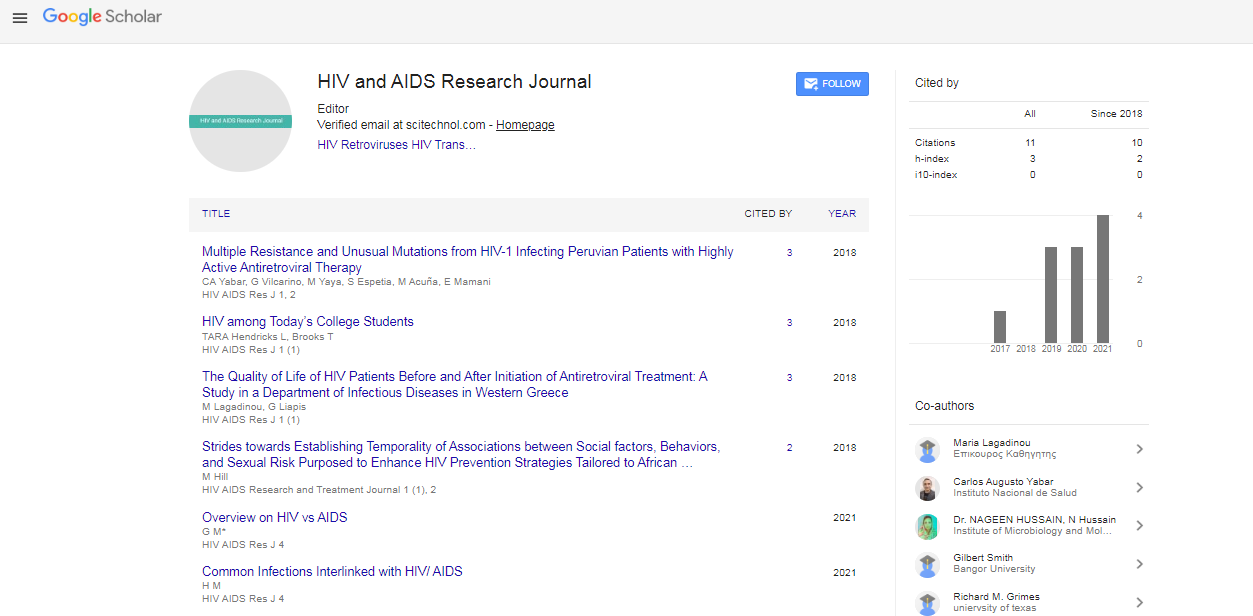Perspective, Hiv Aids Res J Vol: 6 Issue: 1
Impact of Adenovirus Co-infection on HIV and Its Detection
Trevor Noda*
Department of Biotechnology, Osaka University, Osaka, Japan
*Corresponding Author: Trevor Noda
Department of Biotechnology, Osaka
University, Osaka, Japan
E-mail: trevornoda@osu.jp
Received date: 20 February, 2023, Manuscript No. HARJ-23-94961;
Editor assigned date: 22 February, 2023, PreQC No. HARJ-23-94961 (PQ);
Reviewed date: 09 March, 2023, QC No HARJ-23-94961;
Revised date: 16 March, 2023, Manuscript No. HARJ-23-94961 (R);
Published date: 23 March, 2023, DOI: 10.4172/Harj.1000123
Citation: Noda T (2023) Impact of Adenovirus Co-infection on HIV and Its Detection. HIV AIDS Res J 6:1.
Description
Adenoviruses are a group of non-enveloped double-stranded DNA viruses that can cause a variety of infections in humans, including respiratory, gastrointestinal, ocular, and systemic infections. While adenoviruses are typically considered to be self-limiting and cause mild illnesses, they can pose a significant threat to individuals with weakened immune systems, such as those living with HIV/AIDS. The impact of adenovirus coinfection on HIV infection has gained increasing attention in recent years, with emerging evidence shedding light on the complex interplay between these two viral infections. These emerging insights into adenovirus biology and pathogenesis have deepened the understanding of the complex interplay between the virus and the host, and have important implications for the diagnosis, treatment, and prevention of adenovirus infections.
Adenoviruses belong to the Adenoviridae family, which comprises over 100 different serotypes grouped into seven species (A to G). They have a complex virion structure, with a protein capsid enclosing the viral genome. Adenoviruses primarily infect respiratory epithelial cells, but can also target other cell types. The viral replication cycle involves attachment and entry into host cells, viral gene expression and protein synthesis, genome replication, assembly, and release of mature virions. Recent studies has elucidated the intricate molecular mechanisms underlying these processes, including the roles of viral proteins in modulating host cell signaling, disrupting cellular machinery for viral replication, and evading host immune responses.
Adenoviruses can cause a wide range of clinical manifestations, from mild self-limiting respiratory infections to severe systemic diseases. The ability of adenoviruses to evade host immune responses is a key factor in their pathogenesis. Adenovirus coinfection in individuals living with HIV can have several effects. Firstly, adenovirus infection can potentially worsen the clinical course of HIV infection. Adenovirus coinfection has been associated with increased HIV viral load, decreased CD4+ T-cell counts, and accelerated disease progression in some studies. Adenovirus-induced inflammation and immune activation may promote HIV replication and spread, leading to increased viral replication and disease progression.
Furthermore, adenovirus coinfection can cause respiratory or gastrointestinal symptoms that may require medical intervention and impact the overall health and quality of life of individuals living with HIV. Diagnosing adenovirus-HIV coinfection can pose challenges due to overlapping clinical symptoms with other infections and limitations in available diagnostic methods. Adenovirus detection methods include molecular techniques such as Polymerase Chain Reaction (PCR), is the most commonly used molecular method for adenovirus detection, which amplifies adenovirus DNA using specific primers and probes targeting conserved regions of the viral genome.
Real-time PCR, also known as Quantitative PCR (QPCR), allows for rapid and quantitative detection of adenovirus, with the added advantage of high sensitivity and specificity. Other molecular methods, such as loop-mediated isothermal amplification, Nucleic Acid Sequence-Based Amplification (NASBA), and Digital Droplet Polymerase Chain Reaction (DDPCR), have also been used for adenovirus detection. Additionally, managing adenovirus HIV coinfection can be challenging due to limited antiviral treatment options specifically targeting adenovirus. There is currently no specific antiviral therapy approved for adenovirus, and treatment primarily focuses on supportive care and management of complications. The potential for drug interactions and adverse effects also needs to be considered when managing coinfections in individuals living with HIV who are already on Anti-Retroviral Therapy (ART).
Conclusion
Adenovirus coinfection in individuals living with HIV can have significant implications for disease progression, diagnosis, and management. It is essential to recognize the potential impact of adenovirus in the context of HIV coinfection and to develop strategies for accurate diagnosis, management, and prevention. The detection of adenovirus co-infection in people living with HIV is essential for the management of HIV disease, and PCR testing is one of the most common methods used to detect the presence of adenovirus. Regular monitoring of HIV viral load and CD4 cell counts is also important for the management of co-infection and the prevention of disease progression.
 Spanish
Spanish  Chinese
Chinese  Russian
Russian  German
German  French
French  Japanese
Japanese  Portuguese
Portuguese  Hindi
Hindi 